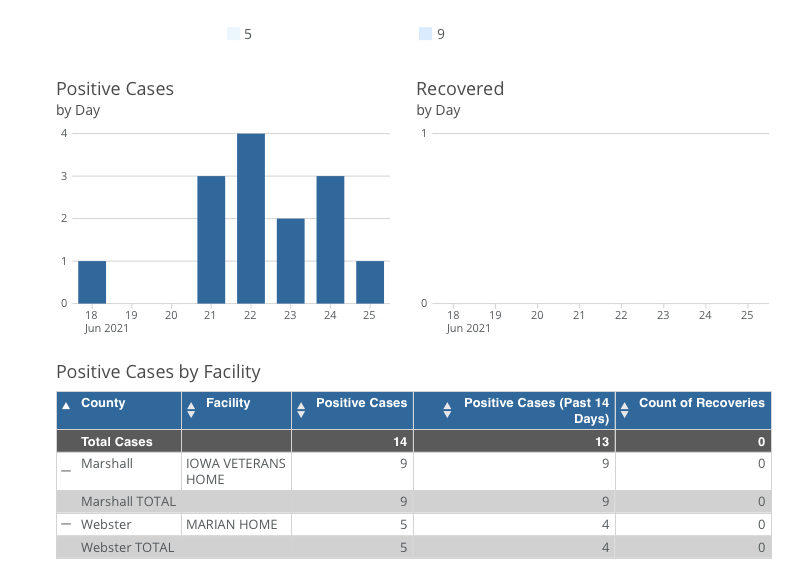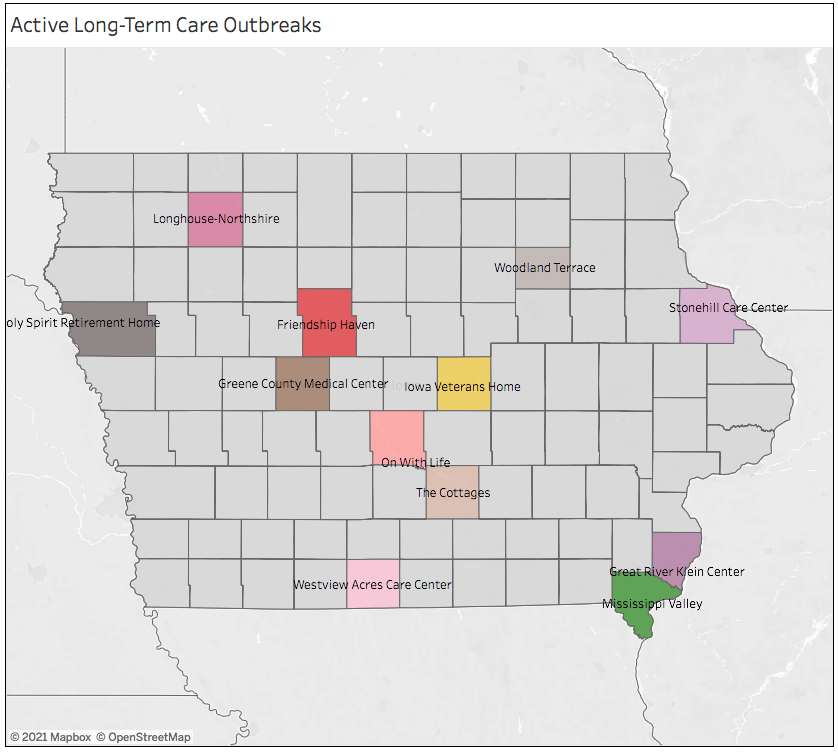State Medical Director and Epidemiologist Dr. Caitlin Pedati asserted that publicly available information about coronavirus cases in Iowa nursing homes is “pretty similar” to what was long disclosed on the state’s official COVID-19 website.
Pedati made the false claim during a wide-ranging interview with Andy Kopsa of Iowa Watch, conducted soon after the state switched from daily to weekly updates on coronavirus.iowa.gov. As part of the revamp, officials removed a page that had shown current outbreaks in long term care facilities.
STATE LONG TERM CARE DATA, THEN AND NOW
Near the 33-minute mark of Kopsa’s interview with Pedati (partly transcribed here), the journalist asked about the website changes: “Am I understanding the reporting correctly, that there’s not going to be any sort of notification of long term care facility outbreaks?”
My transcript of Pedati’s answer:
So there is still a card under the positive case analysis page that says the number of long term care facilities, so this is pretty similar.
I don’t know if you’ve seen the flu reports that the agency puts out every Friday. It’s really quite similar, right? The same types of things that you’ll find in that report are actually all the same components that we’ve talked about with COVID, which makes perfect sense, right? These are respiratory viruses.
So again, you know, increasingly, we’re looking for ways to learn from other diseases and past systems to improve and sort of leverage the resources and lessons learned with COVID to start to create more of a sustainable approach moving forward.
But I will absolutely say, just like I think I’ve said a million times, and I mean it: if things change, we’ll adjust, you know. If there’s a reason to change what we’re doing, or how frequently or that sort of thing, you know, we absolutely will make those changes.
I took this screenshot on July 6, the night before the state took the long-term care page offline.
Iowans could see the name of each nursing home with an active outbreak, the county in which it was located, how many COVID-19 cases had been identified in each facility, when the positive test results came in, and how many of those infected had “recovered” (that is, were alive and not hospitalized 28 days after their positive test).
Here’s the “card” Pedati referenced, which now appears on the positive case analysis page of the state website.
Iowans can now learn only that as of Wednesday, July 21 (the date of the latest weekly update), two nursing homes had active outbreaks. We can’t tell which facilities are affected, or even the county where they are located, let alone how many people have tested positive or the dates of those tests.
Pedati downplayed the significance of the website changes, telling Kopsa, “In terms of the public-facing reporting, you know, what I can share is it’s not that we don’t get those reports anymore, it’s that we are updating them on a weekly basis, right? So, you know, all of public health is still using that information and working with that information.”
That’s little help to Iowans who had been regularly checking the state website to gauge case numbers, positivity rates, hospitalizations, or other trends in their communities.
STATE NEVER PROVIDED COMPLETE DATA ON NURSING HOME CASES
Over the past year, Bleeding Heartland readers with contacts in nursing homes periodically questioned the accuracy of case numbers provided on the state website. One recent example: coronavirus.iowa.gov was still reporting nine total cases at the Iowa Veterans Home in Marshalltown as of July 6. But emails the facility sent to relatives and guardians in late June and early July mentioned seven residents and four employees testing positive. Since then, at least one additional staff member has tested positive, according to an email sent on July 23.
The state also lowballed the number of nursing home outbreaks throughout the pandemic, because the Iowa Department of Public Health’s policy was to disclose an outbreak only if three or more nursing home residents tested positive over a two-week period. The federal government’s Center for Medicare & Medicaid Services (CMS) requires long term care facilities to report every positive case among a resident or staff member. Some states, including Minnesota, publicly disclosed every nursing home that had even one COVID-19 case.
The IDPH never published cumulative data on nursing home outbreaks on coronavirus.iowa.gov. Clark Kauffman of Iowa Capital Dispatch had to file a complaint with the Iowa Public Information Board to get the agency to provide a full list of facilities that had experienced outbreaks.
Agency officials have said they cannot provide details on COVID-19 vaccination rates among nursing home employees, saying the state does not collect that information.
FLU REPORTS PREVIEW FUTURE COVID-19 DISCLOSURE
The IDPH plans to “decommission and archive” its dedicated COVID-19 website by “late summer.” As Pedati mentioned to Kopsa, the state’s weekly influenza reports will be the model for future reporting on the pandemic. Here’s an example. A few numbers are broken down by region, but most statistics are provided only for the state as a whole.
While flu and COVID-19 are both respiratory illnesses, as Pedati noted, they are hardly comparable in their public health impact. In a typical year before the pandemic, flu was a top-ten killer of Iowans, causing between 500 and 700 deaths annually. COVID-19 has already caused 6,170 fatalities in our state. At least 1,427 Iowans have died of the virus during the current calendar year.
Nearly 40 percent of the Iowans who died of COVID-19 (2,429 individuals) had been living in nursing homes, according to CMS data Sara Anne Willette compiled. And while residents of long term care facilities have mostly been vaccinated, they remain more susceptible to severe illness due to weakened immune systems or other health conditions. The two Iowa Veterans Home residents who died in the most recent outbreak were fully vaccinated.
With the Delta variant becoming dominant in Iowa and nationally, and cases and hospitalizations on the rise, now seems like the worst time to scale back publicly available COVID-19 data, especially information related to the most vulnerable population.
INDEPENDENT WEBSITE STILL PROVIDES COMPREHENSIVE DATA
Iowans are fortunate that Willette continues to publish a remarkable amount of information, including a vast array of nursing home data, on her Iowa COVID-19 Tracker website. Whereas the IDPH has kept secret the number of nursing home employees who have died of COVID-19, Willette regularly collects those numbers from CMS and has created a chart showing that 37 long term care staff in Iowa have passed away from the virus. This page shows cumulative numbers of cases and deaths among residents and staff at every facility.
Willette’s graphics on “active long-term care outbreaks” include all nursing homes with any recent cases. Her latest map indicates that as of July 25, fourteen long-term care facilities in twelve counties have had a staffer recently test positive for COVID-19.
I took this photo from a spreadsheet Willette regularly updates. Click the “Data Tables” tab from the front page, and then the “IAC Weekly Data” from OneDrive. The first file is called “ActiveLTCs.xlsx.”
Why does Willette keep such a close eye on staff infections? She told Bleeding Heartland,
Whenever a facility has experienced a large outbreak amongst staff members, a resident outbreak appears to follow within a week or two after the first staff positives have appeared. The worse the staff outbreak, the worse the resident outbreak.
The inverse is also true, as sparse staff positives do not appear to translate into sparse resident positives. The data suggest that managing staff outbreaks is critical in preventing resident outbreaks.
The main drawback of relying on CMS data is the delay. It takes about two weeks for Iowa’s nursing home data to show up on the federal websites Willette uses. The state could do better if transparency and informing the public were priorities. Instead, IDPH leaders are preparing to take coronavirus.iowa.gov offline.
Pedati assured Kopsa, “If there’s a reason to change what we’re doing, or how frequently or that sort of thing, you know, we absolutely will make those changes.” My best advice to Iowans who want to know what’s really happening with the pandemic: bookmark Iowa COVID-19 Tracker.
Top image: Official photo of Dr. Caitlin Pedati, first published on the Iowa Department of Public Health’s website.





